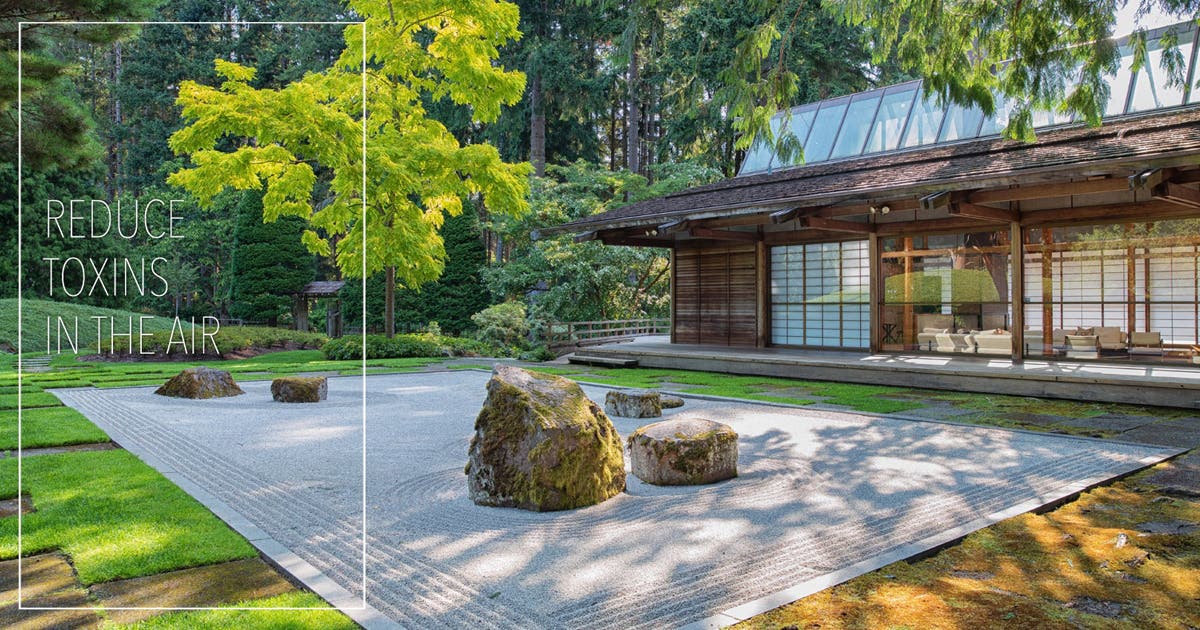
Dr. B.C. Wolverton, researcher and author of “How to Grow Fresh Air – 50 Houseplants that Purify Your Home or Office” , conducted plant studies for NASA which determined that plants have the ability to remove air pollutants in homes, offices, factories and retail outlets. He would later go on to expand the study and assign plants a rating from one to 10, based on a plant’s ability to remove chemical vapors or indoor air toxins, ease of growth and maintenance, resistance to insect infestation and the rate at which water evaporates from the leaves. Below is a list of his top rating plants.

1. Areca Palm (Chrysalidocarpus lutescens)
Also called the “Butterfly Palm”. An upright houseplant that is somewhat vase shaped. Specimen plants can reach 10 to 12 foot in height. Prefers a humid area to avoid tip damage. Requires pruning. When selecting an Areca palm look for plants with larger caliber trunks at the base of the plant. Plants that have pencil thin stems tend to topple over and are quite difficult to maintain. Areca has been awarded a high score of 8.5 as the ideal indoor plant by NASA. Benefits: General air purifier, especially as it grows larger. It's known for being one of the better performers in purifying the air. Notes: Moderately drought tolerant and prefers partial sun and well-drained soil

2. Lady Palm (Rhapis excelsa)
Also called the “Lady Palm”, this durable palm species adapts well to most interiors. The Rhapis are some of the easiest palms to grow, but each species has its own particular environment and culture requirements. The “Lady Palm” grows slowly, but can grow to more than 14′ in height with broad clumps often having a diameter as wide as their height. Benefits: These types of houseplants are said to be a good overall air purifier, removing most air pollutants.

3. Bamboo palm (Chamaedorea seifrizii)
Also called the “reed palm”, this palm prefers bright indirect light. New plants will lose of some interior foliage as they acclimate to indoor settings. This plant likes to stay uniformly moist, but does not like to be over-watered or to sit in standing water. Indoor palms may attract spider mites which can be controlled by spraying with a soapy solution. Benefits: According to NASA, it removes formaldahyde and is also said to act as a natural humidifier

4. Rubber Plant (Ficus robusta)
Grows very well indoors, preferring semi-sun lighting. Avoid direct sunlight, especially in summer. Young plants may need to be supported by a stake. The Ficus grows to 8’ with a spread of 5’. Wear gloves when pruning, as the milky sap may irritate the skin. Water thoroughly when in active growth, then allow the soil to become fairly dry before watering again. In winter keep slightly moist. Benefits: These houseplants clean the air by emitting high oxygen content, and purifies indoor air by removing chemicals, such as formaldahyde or other toxins.

5. Dracaena “Janet Craig” (Dracaena deremensis)
The Dracaena grows to 10’ with a spread of 3’. Easy to grow, these plants do best in bright indirect sunlight coming from the east/west. They can adapt to lower light levels if the watering is reduced. Keep the soil evenly moist and mist frequently with warm water. Remove any dead leaves. Leaf tips will go brown if the plant is under watered but this browning may be trimmed. One of the best houseplants tested for removing trichloroethylene.

6. Philodendron (Philodendron sp.)
Philodendrons are one of the most durable of all house plants. They prefer medium intensity light but will tolerate low light. Direct sun will burn the leaves and stunt plant growth. This plant is available in climbing and non-climbing varieties. When grown indoors, they need to be misted regularly and the leaves kept free of dust. Soil should be evenly moist, but allowed to dry between watering. Philodendrons are particularly good at battling formaldehyde from sources like particleboard.

7. Dwarf Date Palm (Phoenix roebelenii)
A hardy, drought-tolerant and long-lived plant, the Dwarf Date Palm needs a bright spot which is free of drafts. It grows slowly, reaching heights of 8-10’. The Dwarf Date Palm should not be placed near children’s play areas because it has sharp needle-like spines arranged near the base of the leaf stem. These can easily penetrate skin and even protective clothing. Dwarf Date Palm is one of the best for removing indoor air pollutants and is especially adept at removing xylene.

8. Ficus Alii (Ficus macleilandii “Alii”)
The Ficus Alii grows easily indoors, and resists insects. It prefers a humid environment and low to medium light when grown indoors. The Ficus Aliii should not be placed near heating or air conditioning vents, or near drafts because this could cause leaf loss. Soil should be kept moist but allowed to dry between watering.

9. Boston Fern (Nephrolepis exaltata “Bostoniensis”)
The Boston fern grows to 4’ in height with a spread up to 5’. It has feathery ferns which are best displayed as a hanging plant. It prefers bright indirect sunlight. Keep the soil barely moist and mist frequently with warm water. This plant is prone to spider mites and whitefly which can be controlled using a soapy water spray. Inspect new plants for bugs before bringing them home. is the most efficient plant at removing formaldehyde from the air (the most common indoor air pollutant) and for adding humidity to the indoor environment.

10. Peace Lily (Spathiphyllum “Mauna Loa”)
The Peace Lily is a compact plant which grows to a height of 3’ with a 2’ spread. This hardy plant tolerates neglect. It prefers indirect sunlight and high humidity, but needs to be placed out of drafts. For best results, the Peace Lily should be thoroughly watered, then allowed to go moderately dry between waterings. The leaves should be misted frequently with warm water. This tropical plant breaks down and neutralizes toxic gases like benzene, formaldehyde, and carbon monoxide. It's also said to remove mold spores in the air, making it great for bathrooms, kitchens and laundry rooms; purifying the air of trichloroethylene, a chemical found in cleaners and solvents; and removing alcohols, acetone, and formaldehyde.
Everything You Need To Know About Futons




 What Houseplants Are Best For Cleaning The Air?
What Houseplants Are Best For Cleaning The Air? What To Consider When Buying A Futon?
What To Consider When Buying A Futon? Why Buy A Futon?
Why Buy A Futon? What Wood Is Best For Beds?
What Wood Is Best For Beds? What Are Futon Frame Styles?
What Are Futon Frame Styles? What's The Most Comfortable Futon Mattress?
What's The Most Comfortable Futon Mattress? What Are The Sizes Of Futons?
What Are The Sizes Of Futons? How To Care And Maintain Your Futon?
How To Care And Maintain Your Futon? What Furniture Is Best For My Health?
What Furniture Is Best For My Health? What Causes Poor Indoor Air Quality?
What Causes Poor Indoor Air Quality? Do Mattresses Contain Volatile Organic Compounds (VOCs)?
Do Mattresses Contain Volatile Organic Compounds (VOCs)? Sleep VOC Free
Sleep VOC Free What Is Off Gassing?
What Is Off Gassing?






